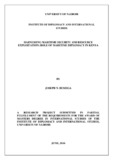| dc.description.abstract | Maritime security, despite its common usage, is not an easy term to define because it involves a wide range of concerns. The blue economy forms a large stake of most African nation-states and many have significant maritime security challenges. The study purposed to establish facts on harnessing maritime security and resource exploitation utilizing maritime diplomacy in Africa with a focus on Kenya. The study was influenced by the fact that at the moment the maritime sector, the Indian Ocean and its inland water bodies plus rivers are of great importance and that the ‘Blue economy’ is becoming an important concern. Population increment and coastal migration put a lot of pressure on the available resources, in the process making people resort to practices that eventually lead to maritime environmental damage. The study employed Neo-realism Theory to assess the research. The research adopted exploratory research design and this is where the study sought to establish deeper facts of a new idea in order to get a better understanding about it. The study focused on Kenya as a whole, covering at least the major Counties in trying to understand harnessing maritime security and resource exploitation utilizing maritime diplomacy. The study respondents included Sea fearers; Kenya Ports Authority, Marine police, Ministry of Tourism, Kenya Maritime Authority, Dock Workers Union, Ministry of Devolution and Planning, National Intelligence Serves, Kenya Defence Forces, Fisheries department, Ministry of Foreign Affair, Africa Union and others stake holders. Purposive sampling in this case was utilized to produce maximum variation within a sample. The key informants were key stake holders in marine security. Secondary data was collected through journals, books, articles and periodicals. Primary data collection was done using the qualitative and quantitative research approach, thus the primary data was collected using key informant and questionnaire interview. The final results (outcomes) obtained was finally presented by use of frequency tables, pie charts, narratives and bar graphs. The study adhered to appropriate research procedures as stipulated by learning institution, and all sources of information were acknowledged and the researcher followed proper guidance from the supervisor. The study found that the total value of the maritime opportunity available to the Region and Kenya as a whole is estimated to be way worth billions of dollars, and yet majority of it remains largely unharnessed. The research concludes that maritime security is an important element in enabling effective harnessing of maritime resources, and thus requires a multi-agency approach to protect it and effectively deal with issues such as securing the regions maritime wealth together with the nation-state exclusive economic zones, territorial seas, internal seas, inland rivers, ports, and waterways. The study thus emphasizes that transoceanic security and maritime diplomacy cooperation in the region is very important. The study recommends that the stakeholders should seriously consider the enhancement of maritime capacity through deliberate and specialized training and step-up maritime diplomacy capacity building among the naval powers by promoting joint exercises or maritime security operations that strengthen bonds between allies. | en_US |



